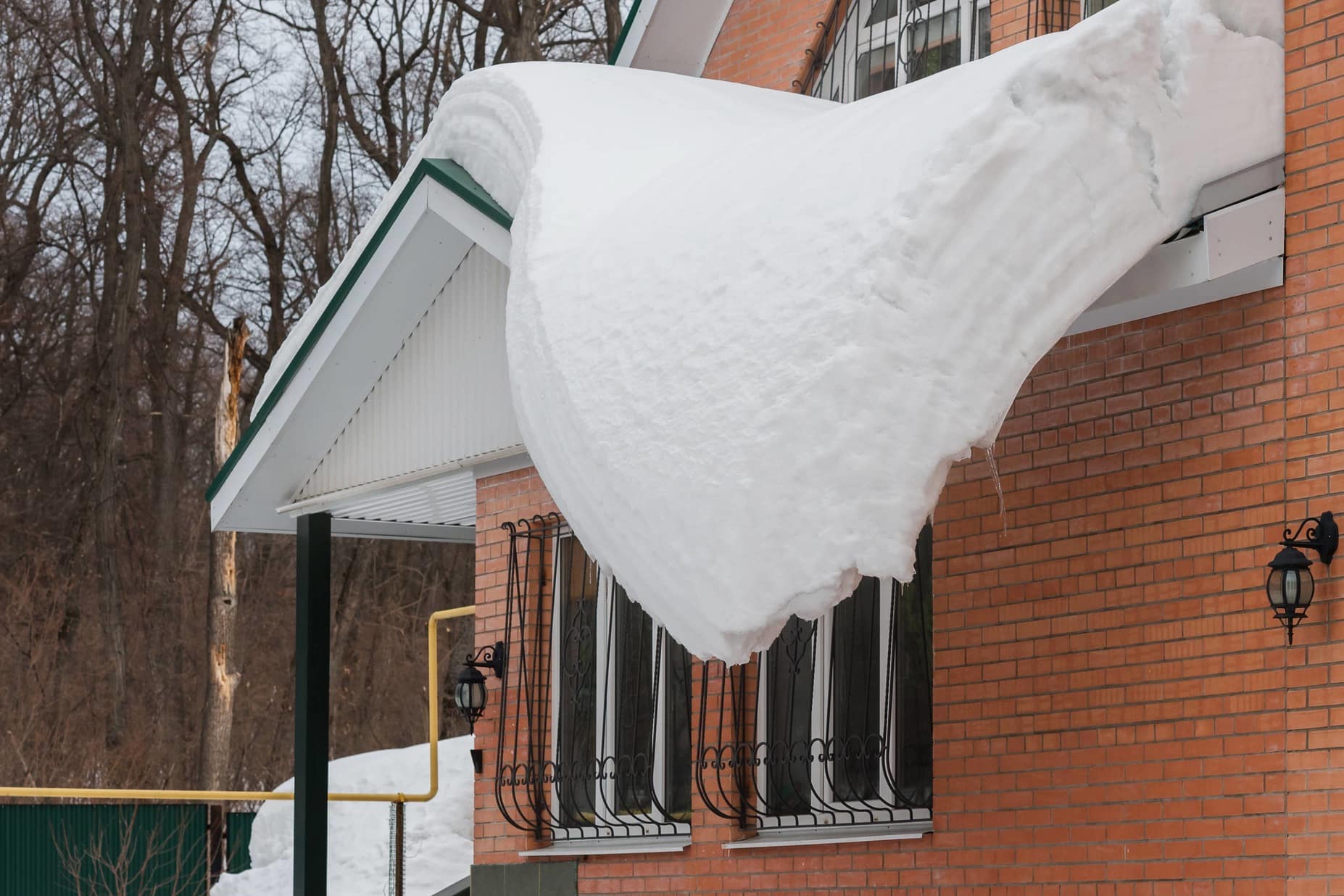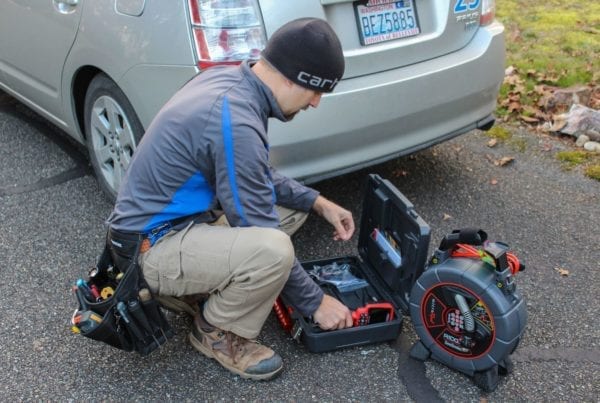
Snow is beautiful when it falls, covering the ground and the homes with a white blanket that glistens in the sunlight. However, many people are afraid that too much snow on the roof can cause problems. How do you remove snow from the roof? The answer is you may not need to! Roofs can hold up to 20 pounds of snow per square foot so you can often leave it there. On the other hand, if it is more than that, you may need to remove it. Do you have a steep pitched roof? Then most of it will fall off. If not, you can use a special snow rake for the roof, add heating cables to the roof, or add on snow guards.
Let’s take a look at how to calculate the amount of snow that is on your roof, signs of overstressed roofs with snow, ice dams, how to clean the roof safely, maintenance ideas in warmer months, and when to call a professional.
Calculating the Amount of Snow on the Roof
Various amounts of snow will accumulate on the roof, depending on how close the snowstorms are to each other, the amount of snow that falls, and if it melts or ices over. Some roofs are older than others and can’t hold as much. How do you know if you have too much snow and need to remove it?
Let’s look at how to figure this out:
If an inch of snow weighs 1.25 pounds, your equation is Sx1.25=P
S = inches of snow
P= pounds of snow per square foot on the roof
If you just had 10 inches of snowfall from a storm, 10×1.25= 12.5 pounds of snow on the roof. For most roofs, this amount is just fine.
Contacting a professional to take a look at your roof, the age of your roof, and to let you know how much it can hold is a good idea and useful information for you to know. However, for the most part, you really do not have anything to worry about.
Overstressed Roofs Are a Sign Snow Needs to Be Removed
FEMA says that homes can show signs of deterioration after a snow event. Here are some signs that wood, steel, and metal roofs are holding too much snow.
- Sagging in the tiles on the ceiling and boards are falling – you may notice some of the ceiling is coming out of place or falling. This can be a sign that there is too much snow on the roof or there is damage.
2. Noises in the ceiling– you may hear popping and cracking and these sounds can signal that there is stress on the roof. It is important to have this inspected quickly as this is not normal.
3. Cracks in masonry and walls– if you see cracks starting to form, this could be due to the roof structure is not able to hold the snow.
4. Accumulation of water where there is usually no drainage issue, roof leaks, bowing truss bottom and chords, and doors that don’t open and close are all signals the roof is in distress.
If you have any of these issues after a snow event, contact a professional right away. These sights and sounds can be dangerous.
How to Remove Snow Off the Roof Safely
It is dangerous to get on a ladder and climb on the roof. In fact, walking on the roof, with snow accumulation or even ice (which is heavier than snow) could cause you to fall, injury, or even death. The roof is only so strong that it is quite possible to fall through or slip.
Here is a video below of ways to clean snow off the roof safely, without going on the ladder.
1. Snow Rake for the Roof
One way to clean snow off the roof is by using a snow rake It is different than a yard rake and won’t destroy the roof shingles or cause holes in the roof.
- Check the roof first (if you can) for loose shingles.
2. Look above for power lines to make sure you don’t get the pole near the lines.
3. If you have a shorter house and the rake can reach the highest point of the house, this will work best.
4. Stand in a safe spot on the ground. Check that you have the correct length for the snow rake and have room to start at the ridge of the roof.
5. Push the snow rake up towards the middle of the roof towards the ridge and pull the rake back.
6. Knock the snow off on to the ground and repeat.
Helpful Tips When Using a Snow Rake
Be aware that piling the snow up too high on the ground may cause flooding when it melts so try to keep it away from the foundation of the house. Another idea is to put it in a wheelbarrow to move it farther from the home.
Be careful of your gutters. If you notice they are blocked and not allowing water to flow well, you will need to clean them out so you don’t have ice dams or ice build-up develop.
Try to get all the snow off from the ridge and bring it down carefully off the house. Leave maybe an inch on the roof so you don’t get near the shingles and cause damage. You may need to perform the steps above the next time there is a 2-inch snowfall to avoid ice dams from forming.
Remove Snow From the Roof So Ice Dams Can’t Form
Ice dams may form at the edge of the roof and block water from falling off the sides. When this happens, the water backs up and then goes into the home. It is important to keep an eye out for ice dams as you don’t want them to form.
One way to avoid this is to make sure the snow is removed from the roof plane. That is the highest part of the roof that has a flat side and four separate edges. As mentioned above, bring the snow all the way down the roof and let it fall on the ground. If not, you risk ice dams forming.
Causes of Ice Dams
Attic air leaks – these are also known as attic bypasses and warmed air is allowed to enter the attic space. This occurs underneath the formation of the ice dam. You may not know this is happening, but having an inspector use infrared thermography allows him/her to find where the air is escaping.
Lack of attic ventilation and insulation– It is important to have enough ventilation and insulation in an attic. If there is not, the attic becomes too warm and then causes the snow to melt on the roof.
Then, the freezing temps will cause the melted water to build up into small dams . If you suspect any of these issues are happening, contact a professional to check it out for you. Taking care of these issues will help you avoid the problems discussed below.
Double Ice Dams
If you stop at the end of the roof, ice dams can form at the top of the ridge. This is called a double ice dam, and you will have more problems and destruction if this happens.
If you can’t reach the top of the roof from the ground with a snow rake, you may need to carefully climb on a ladder to get the snow down or call a professional.

Ice Dams and Gutters
The dams can also occur in the gutters so make sure these stay clean and water is flowing through. It is a good idea to have a downspout on your home to carry the melting water and debris through the gutters and down to the ground so it doesn’t accumulate at the edge of the roof.
2. Heating Cables Can Remove Snow From the Roof
These are cables that can be added on to the roof of the house and will melt the snow. You can add them to the roof before winter, or plan ahead in the warmer months. They can stay on the roof all year, but you want to turn them on only when it is necessary in the winter. Be aware, they will raise your electric bill.
What is great about them is they prevent damage to not only the roof, but also downspouts, roofs, and gutters. Heating cables can usually be used on metal roofs and roofs that have non-combustible shingles.
However, read the packaging to make sure it is compatible with your type of roof. A good recommendation is to have them professionally installed so you know they are on the roof correctly and will do their job.

3. Snow Guards Can Help Remove Snow From the Roof
Snow guards can be installed on most roofs and keep the snow from sliding off the roof all at once. In most cases, it will allow for the gradual sliding of snow off the house and allow slower melting. You might be asking why would I not want it to slide off all at once?
Well, if it does and the snow is heavy, it will fill the gutters and knock them off because of the weight. Then, after the snow melts, you will be replacing your gutters. Also, the snow can also come down quickly on a person below and cause injury. You don’t want that to happen so snow guards will help prevent it.
Maintenance Ideas In the Warmer Months
Gutters
Make sure the gutters are clean of debris and water flows well through them as mentioned above. The warmer months of the year are a great time to make sure everything works well.
Drip Edge Flashing
If you don’t have drip edge flashing at the edge of your roof, it might be a good idea to install it. This will help keep water away from the fascia and will protect the underneath areas as well as the shingles from damage.
Visual Roof Inspection
Do a visual roof inspection from the ground or safely climb a ladder and look for missing shingles or other issues during the warmer months. You don’t want any surprises when the first snowstorm or freeze comes through.
When to Call a Professional to Remove Snow From the Roof
Depending on your roof type, the suggestions above may or may not work. Every roof is different in slope and also material. You want to make sure you are cautious and make the right decisions. It never hurts to call a professional to do these things above for you.
Conclusion
Think about the amount of snow you usually get on your home and the quality of your roof to decide if you need to invest the time and money into the suggestions. If you have questions or need suggestions for assistance installing any of the ideas above, leave us a reply below so we can help!



